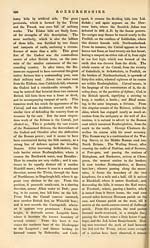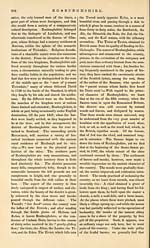Gazetteer of Scotland > Volume 2
(421) Page 901 - ROX
Download files
Complete book:
Individual page:
Thumbnail gallery: Grid view | List view

ROXBURGHSHIRE.
901
the Tiviot, and runs through the enclosures of
Mount Tiviot ; the road now courses north-
north-east, in a straight line, for upwards of
three miles, between the parish of Ancrum, on
the west, and the parish of Maxton, on the
east. Entering now the parish of Lessudden,
it crosses Leiret burn ; and traversing St. Bos-
well's green, it passes Bowden burn, above
Newton. From this passage, the road pro-
ceeds, in a north-north-west direction, along
the eastern base of the Eildon hills, to the
Tweed. Having crossed this river, at the
ford, which was opposite to Melrose, the
road went northward along the western side of
the Leader water, nearly in the track of the
present highway to Lauder, to a Roman sta-
tion, called Chester-lee, which was placed on
the north side of a rivulet, which falls into the
Leader, above Clackmae. The Roman road,
having passed the station of Chester-lee, about
three quarters of a mile, may still be easily
traced, for a considerable distance ; crossing
the turnpike, and a small brook, which mingles
its waters with the Leader, below Chapel.
From hence, the Roman road, proceeding
northward to a small station, called the Waas
or Walls, near to New Blainslee, again ap-
pears, distinctly, for almost a mile and a
half, when it again crosses the turnpike
road, and immediately afterwards a rivulet,
about half a mile east-north-east from
Cheildhells' chapel ; whence it pushes up
Lauderdale, through Berwickshire. There
was another Roman road, which is called the
Maidenway ; and which came down from the
Maiden castle on Stanmore, in Westmoreland,
and through Severus's wall, at Caervaran, into
Liddisdale, at a place called Deadwater :
Whence, under the name of the Wheel Cause-
way, it traverses the north-east corner of Lid-
disdale ; and along the eastern side of Needs-
law into Tiviotdale. This way cannot now
be traced throughout that vale ; neither is it
certain, whether it ever joined the Watling
Street, within the limits of Roxburghshire.
But a chain of Roman posts, as we know
from remains, was certainly established through-
out this county. The abdication of the Ro-
man government, during the fifth century, and
their retreat from the soft margin of the Ti-
viot, and the pleasant banks of the Tweed, are
memorable eras in the history of Roxburgh-
shire. It was soon invaded by a very different
race of conquerors. The Romanized Ottadini
and Gadeni, the real possessors of the country,
from ancient descent, struggled for a while
against their invaders. They tried to repaii
their hill-forts, after the Roman manner. They
erected military lines, for defending their na-
tive land, which emulate, in their construc-
tion and magnitude, the Roman ramparts.
But though they struggled bravely, it was with-
out ultimate success. The Saxons gained upon
them. And, before the conclusion of the sixth
century, the new people appear to have oc-
cupied Tiviotdale, and the eastern district of
Roxburghshire. Included in the kingdom of
Northumberland, it partook with it of its pros-
perity and of its decline. It was relin-
quished by the Earl of Northumberland, as
part of Lothian, to the Scottish King, in 1020.
There is another class of antiquities in Rox-
burghshire worthy of notice. These are
towers or castles built of " lyme and stane,"
after the accession of Robert Bruce, during
the ages of civil anarchy and wastefid wars.
Like those of Peebles-shire, they were all
built with a view to security. The castle
of Jedburgh was a strong edifice, erected as
early as the accession of David I. ; and is
indeed the earliest castle in this shire,
of which any distinct account can be given.
The castle of Roxburgh, indeed, may vie
with it in its antiquity, and claim a pre-
eminence as a strength, and a decided su-
periority as a royal burgh. Hermitage castle,
in Liddisdale, the next greatest strength,
was built during the able reign of Alexander
III. by Comyn, Earl of Monteith. The other
castles are of lesser note. The district of
Roxburghshire was, in ancient times, still more
distinguished for its religious structures, and
few places in Scotland yield such interesting
monastic annals. The abbeys of Jedburgh
and Melrose, which we have amply described
in their appropriate places, stood at the head
of their class, both for the architectural gran-
deur of the edifices and the eminence and
wealth of their establishments. The abbey of
Kelso was likewise an institution of almost
equal importance, and, including the abbey of
Dryburgh, which happens to be in a parish at-
tached to Berwickshire, there was a formed
cluster of monastic institutions unrivalled in
Scotland, at least within so small a compass ;
and it may be supposed that, when in full ope-
ration, the whole of this beautiful district would
be a complete halidome, teeming with ecclesi-
901
the Tiviot, and runs through the enclosures of
Mount Tiviot ; the road now courses north-
north-east, in a straight line, for upwards of
three miles, between the parish of Ancrum, on
the west, and the parish of Maxton, on the
east. Entering now the parish of Lessudden,
it crosses Leiret burn ; and traversing St. Bos-
well's green, it passes Bowden burn, above
Newton. From this passage, the road pro-
ceeds, in a north-north-west direction, along
the eastern base of the Eildon hills, to the
Tweed. Having crossed this river, at the
ford, which was opposite to Melrose, the
road went northward along the western side of
the Leader water, nearly in the track of the
present highway to Lauder, to a Roman sta-
tion, called Chester-lee, which was placed on
the north side of a rivulet, which falls into the
Leader, above Clackmae. The Roman road,
having passed the station of Chester-lee, about
three quarters of a mile, may still be easily
traced, for a considerable distance ; crossing
the turnpike, and a small brook, which mingles
its waters with the Leader, below Chapel.
From hence, the Roman road, proceeding
northward to a small station, called the Waas
or Walls, near to New Blainslee, again ap-
pears, distinctly, for almost a mile and a
half, when it again crosses the turnpike
road, and immediately afterwards a rivulet,
about half a mile east-north-east from
Cheildhells' chapel ; whence it pushes up
Lauderdale, through Berwickshire. There
was another Roman road, which is called the
Maidenway ; and which came down from the
Maiden castle on Stanmore, in Westmoreland,
and through Severus's wall, at Caervaran, into
Liddisdale, at a place called Deadwater :
Whence, under the name of the Wheel Cause-
way, it traverses the north-east corner of Lid-
disdale ; and along the eastern side of Needs-
law into Tiviotdale. This way cannot now
be traced throughout that vale ; neither is it
certain, whether it ever joined the Watling
Street, within the limits of Roxburghshire.
But a chain of Roman posts, as we know
from remains, was certainly established through-
out this county. The abdication of the Ro-
man government, during the fifth century, and
their retreat from the soft margin of the Ti-
viot, and the pleasant banks of the Tweed, are
memorable eras in the history of Roxburgh-
shire. It was soon invaded by a very different
race of conquerors. The Romanized Ottadini
and Gadeni, the real possessors of the country,
from ancient descent, struggled for a while
against their invaders. They tried to repaii
their hill-forts, after the Roman manner. They
erected military lines, for defending their na-
tive land, which emulate, in their construc-
tion and magnitude, the Roman ramparts.
But though they struggled bravely, it was with-
out ultimate success. The Saxons gained upon
them. And, before the conclusion of the sixth
century, the new people appear to have oc-
cupied Tiviotdale, and the eastern district of
Roxburghshire. Included in the kingdom of
Northumberland, it partook with it of its pros-
perity and of its decline. It was relin-
quished by the Earl of Northumberland, as
part of Lothian, to the Scottish King, in 1020.
There is another class of antiquities in Rox-
burghshire worthy of notice. These are
towers or castles built of " lyme and stane,"
after the accession of Robert Bruce, during
the ages of civil anarchy and wastefid wars.
Like those of Peebles-shire, they were all
built with a view to security. The castle
of Jedburgh was a strong edifice, erected as
early as the accession of David I. ; and is
indeed the earliest castle in this shire,
of which any distinct account can be given.
The castle of Roxburgh, indeed, may vie
with it in its antiquity, and claim a pre-
eminence as a strength, and a decided su-
periority as a royal burgh. Hermitage castle,
in Liddisdale, the next greatest strength,
was built during the able reign of Alexander
III. by Comyn, Earl of Monteith. The other
castles are of lesser note. The district of
Roxburghshire was, in ancient times, still more
distinguished for its religious structures, and
few places in Scotland yield such interesting
monastic annals. The abbeys of Jedburgh
and Melrose, which we have amply described
in their appropriate places, stood at the head
of their class, both for the architectural gran-
deur of the edifices and the eminence and
wealth of their establishments. The abbey of
Kelso was likewise an institution of almost
equal importance, and, including the abbey of
Dryburgh, which happens to be in a parish at-
tached to Berwickshire, there was a formed
cluster of monastic institutions unrivalled in
Scotland, at least within so small a compass ;
and it may be supposed that, when in full ope-
ration, the whole of this beautiful district would
be a complete halidome, teeming with ecclesi-
Set display mode to: Large image | Transcription
Images and transcriptions on this page, including medium image downloads, may be used under the Creative Commons Attribution 4.0 International Licence unless otherwise stated. ![]()
| Gazetteers of Scotland, 1803-1901 > Gazetteer of Scotland > Volume 2 > (421) Page 901 - ROX |
|---|
| Permanent URL | https://digital.nls.uk/97435874 |
|---|
| Description | Volume II: Glenbanchor to Zetland. |
|---|---|
| Attribution and copyright: |
|
| Description | By Robert Chambers and William Chambers. Glasgow: Blackie & Son, 1838. 2 volumes. |
|---|---|
| Shelfmark | NF.1461.g.7 |
| Additional NLS resources: | |

